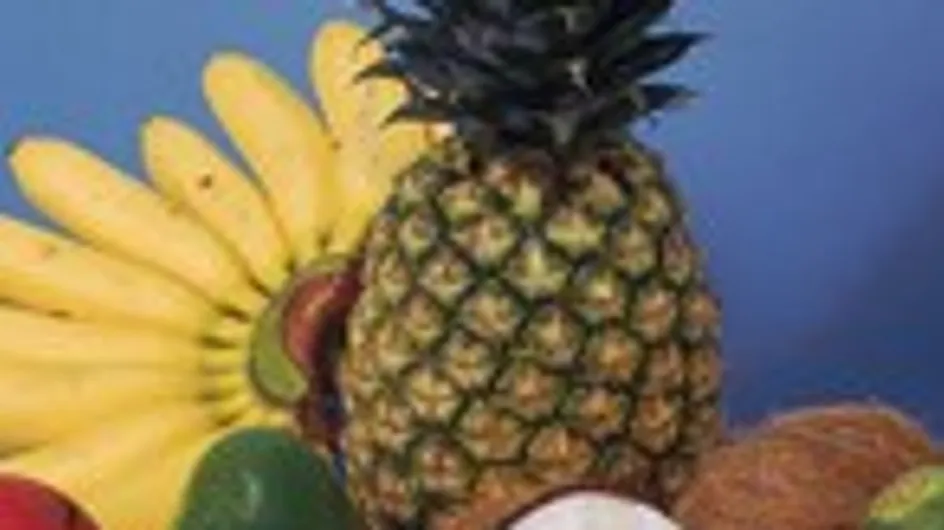Winter is the season for tropical fruit, it being summer over on the other side of the Equator, which is why you often see dates and other exotic delights on the table during the festive season. Fruit that has been imported from faraway climes will have had longer to ripen and will be sweeter.
See all our tropical fruit recipes
Pineapple
- A good pineapple should be heavy, perfumed and firm to the touch. The colour doesn't tell you that much about how ripe it is, but if the leaves are green and shiny and come away easily, it's ready to eat.
- Store whole pineapples at ambient temperature and once opened, cling film and keep in the fridge for up to 5 days.
- Pineapple is great at the end of a meal, because it contains an enzyme that aids protein absorption and digestion when eaten raw. The different varieties of pineapple can weigh anything from 500g to a whopping 2kg.
- The best pineapples: Victoria pineapples. They're small, sweet, and hail from Mauritius and Reunion.
Banana
- Bananas are common, but exotic nonetheless! They come from faraway shores like Martinique, Guadeloupe, the Ivory Coast and Kenya. Some like theirs firm and just ripe, whereas others like theirs bananas well ripe, with a spotted skin and a soft inside. Banana flesh can turn floury if the fruit is picked too early. You don't need to refrigerate bananas, and refrigeration alters their texture.
- If you want your bananas to ripen faster, place them near an apple.
- Drizzle lemon over bananas when chopping them up for fruit salad so that they don't go brown (bananas oxidise extremely fast).
Starfruit
- The starfruit is a long berry around 5-8cm long, with 5 sides that give it that beautiful star shape when sliced. Its flesh is yellow to white and it has a texture not unlike that of apples: fresh, crunchy and juicy, with a taste a bit like Spanish melons.
- When choosing starfruit, go for firm fruit with shiny, gold-yellow skin. Light spotting of the skin is a good sign the fruit is ripe.
- You can eat starfruit as it comes, raw or very lightly cooked. It's great for decoration. Keep refrigerated for 2-15 days, depending on how ripe it is at first.
Dates
- Fresh dates come in bunches, attached to stems. The fruit is quite small, long in shape and yellowy-orange in colour. They should be kept refrigerated in an airtight container, because they easily absorb smells, or you can simply leave them out in the air to dry up.
- Dried dates sold in bunches or packed separately have a wrinkled, brown, slightly transparent skin. They will keep for almost a year in an airtight container. They can be coated in glucose syrup to preserve them better, but dates are naturally very sweet so these are best avoided. The Tunisian deglet-noor date is one of the most popular. The medjool or medjoul date, which is bigger and softer, with a flavour not unlike iced chestnuts and a thick, melt-in-the-mouth texture, is one of the best and most expensive varieties.
Passionfruit
- Known as the grenadilla in the Americas, the passionfruit is a berry with purple, red, orange or yellow skin and an uneven, wrinkled surface. The flesh is acidic, orange-yellow in colour and packed with little edible black seeds.
- It should be kept at room temperature for a few days. The more wrinkled the fruit, the riper it is.
Guava
- The fruit of the guava tree is also a berry. It's round or oval, with smooth skin, and green to light yellow in colour. The flesh is anything from red to pink to pale yellow, depending on the variety.
- You can eat guava cooked, raw, juiced, in sorbet, syrup and candied fruit. We don't see much fresh guava because it's very fragile and difficult to import.
Pomegranate
- Another exotic berry, the pomegranate is round and slightly bigger than a tennis ball, with a thick, pinkish, shiny, usually smooth skin. As it ripens, the skin darkens, thins and hardens. The inside is made up of fresh, crunchy red or pink seeds that are slightly bitter and sharp in taste.
- It can be eaten as it comes, in salads, or drizzled in honey and orange blossom... mmm.
- A ripe pomegranate should be red to orange-brown, shiny and smooth. It should feel heavy in your hand, a sure sign the inside is nice and juicy.
Kumquat
- A kumquat is a small, oval, orange-yellow citrus fruit around 4-5cm long. It has an acidic flavour that makes it quite bitter.
- The skin is edible, but needs blanching for a few seconds before eating. Kumquat is used to flavour jam, fruit purée and sweet and sour sauce, and is often found in candied form used for decoration.
Lychee, rambutan and longan
- Lychees are small white fruit. They're not crunchy but not soft either, and have a sweet, refreshing taste.
- The ramboutan fruit is a bit rarer, but just as delicious. It's larger than the lychee, with a similar colour and hairy skin. Its flesh is firmer (almost crunchy), and it has a finer, fresher, but not as sweet taste as a lychee. Try one!
- Another similar fruit is the longan, which looks something like a big grape with dull skin. It has a very fine taste and a huge seed, like the wild cherry.
Mango
- When mangoes are ready to eat, they should be quite heavy and firm but soft to the touch (though they shouldn't be so soft you can dent them with your fingers!). Over-ripe mangoes are very sweet, and can taste sickly.
- To chop a mango, slice the sides off using a good knife, around the pit. Then slice the remaining flesh off around the pit and either cube the mango cheeks hedgehog style or slice them up as you want, removing the skin.













